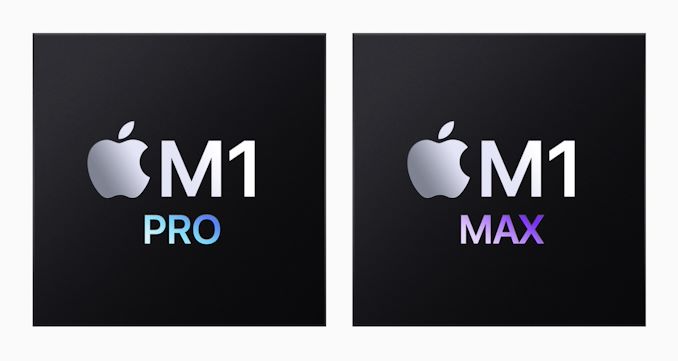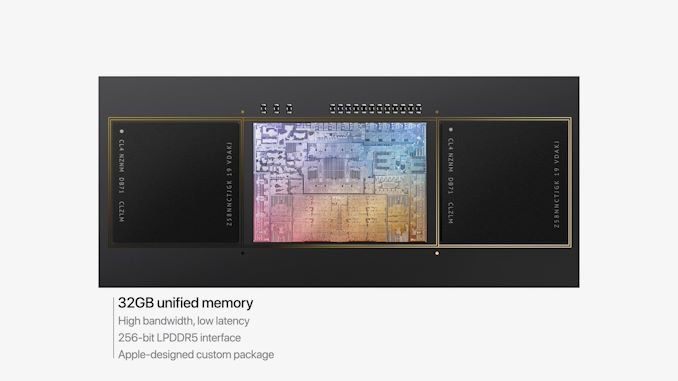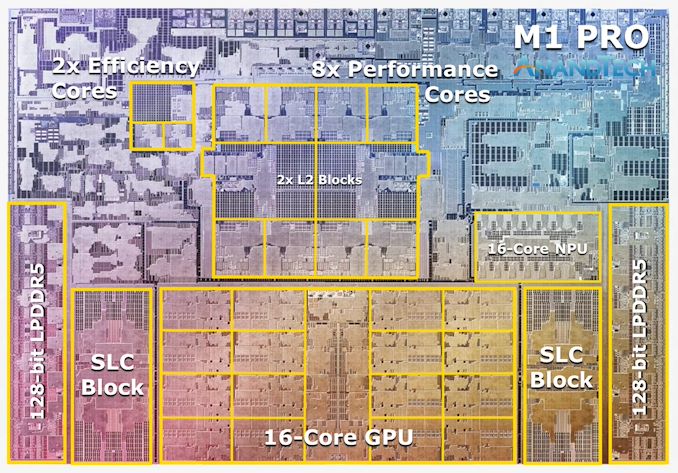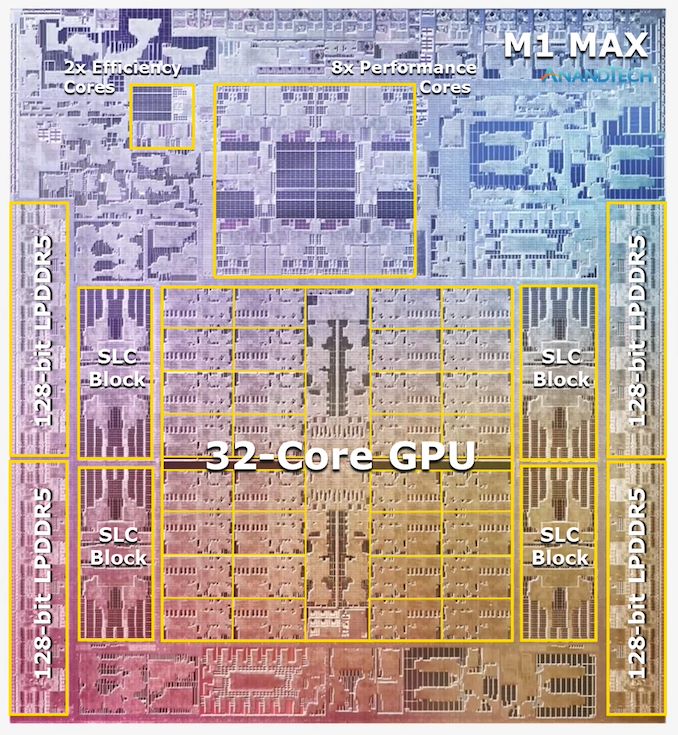Apple's M1 Pro, M1 Max SoCs Investigated: New Performance and Efficiency Heights
by Andrei Frumusanu on October 25, 2021 9:00 AM EST- Posted in
- Laptops
- Apple
- MacBook
- Apple M1 Pro
- Apple M1 Max

Last week, Apple had unveiled their new generation MacBook Pro laptop series, a new range of flagship devices that bring with them significant updates to the company’s professional and power-user oriented user-base. The new devices particularly differentiate themselves in that they’re now powered by two new additional entries in Apple’s own silicon line-up, the M1 Pro and the M1 Max. We’ve covered the initial reveal in last week’s overview article of the two new chips, and today we’re getting the first glimpses of the performance we’re expected to see off the new silicon.
The M1 Pro: 10-core CPU, 16-core GPU, 33.7bn Transistors
Starting off with the M1 Pro, the smaller sibling of the two, the design appears to be a new implementation of the first generation M1 chip, but this time designed from the ground up to scale up larger and to more performance. The M1 Pro in our view is the more interesting of the two designs, as it offers mostly everything that power users will deem generationally important in terms of upgrades.
At the heart of the SoC we find a new 10-core CPU setup, in a 8+2 configuration, with there being 8 performance Firestorm cores and 2 efficiency Icestorm cores. We had indicated in our initial coverage that it appears that Apple’s new M1 Pro and Max chips is using a similar, if not the same generation CPU IP as on the M1, rather than updating things to the newer generation cores that are being used in the A15. We seemingly can confirm this, as we’re seeing no apparent changes in the cores compared to what we’ve discovered on the M1 chips.
The CPU cores clock up to 3228MHz peak, however vary in frequency depending on how many cores are active within a cluster, clocking down to 3132 at 2, and 3036 MHz at 3 and 4 cores active. I say “per cluster”, because the 8 performance cores in the M1 Pro and M1 Max are indeed consisting of two 4-core clusters, both with their own 12MB L2 caches, and each being able to clock their CPUs independently from each other, so it’s actually possible to have four active cores in one cluster at 3036MHz and one active core in the other cluster running at 3.23GHz.
The two E-cores in the system clock at up to 2064MHz, and as opposed to the M1, there’s only two of them this time around, however, Apple still gives them their full 4MB of L2 cache, same as on the M1 and A-derivative chips.
One large feature of both chips is their much-increased memory bandwidth and interfaces – the M1 Pro features 256-bit LPDDR5 memory at 6400MT/s speeds, corresponding to 204GB/s bandwidth. This is significantly higher than the M1 at 68GB/s, and also generally higher than competitor laptop platforms which still rely on 128-bit interfaces.
We’ve been able to identify the “SLC”, or system level cache as we call it, to be falling in at 24MB for the M1 Pro, and 48MB on the M1 Max, a bit smaller than what we initially speculated, but makes sense given the SRAM die area – representing a 50% increase over the per-block SLC on the M1.
The M1 Max: A 32-Core GPU Monstrosity at 57bn Transistors
Above the M1 Pro we have Apple’s second new M1 chip, the M1 Max. The M1 Max is essentially identical to the M1 Pro in terms of architecture and in many of its functional blocks – but what sets the Max apart is that Apple has equipped it with much larger GPU and media encode/decode complexes. Overall, Apple has doubled the number of GPU cores and media blocks, giving the M1 Max virtually twice the GPU and media performance.
The GPU and memory interfaces of the chip are by far the most differentiated aspects of the chip, instead of a 16-core GPU, Apple doubles things up to a 32-core unit. On the M1 Max which we tested for today, the GPU is running at up to 1296MHz - quite fast for what we consider mobile IP, but still significantly slower than what we’ve seen from the conventional PC and console space where GPUs now can run up to around 2.5GHz.
Apple also doubles up on the memory interfaces, using a whopping 512-bit wide LPDDR5 memory subsystem – unheard of in an SoC and even rare amongst historical discrete GPU designs. This gives the chip a massive 408GB/s of bandwidth – how this bandwidth is accessible to the various IP blocks on the chip is one of the things we’ll be investigating today.
The memory controller caches are at 48MB in this chip, allowing for theoretically amplified memory bandwidth for various SoC blocks as well as reducing off-chip DRAM traffic, thus also reducing power and energy usage of the chip.
Apple’s die shot of the M1 Max was a bit weird initially in that we weren’t sure if it actually represents physical reality – especially on the bottom part of the chip we had noted that there appears to be a doubled up NPU – something Apple doesn’t officially disclose. A doubled up media engine makes sense as that’s part of the features of the chip, however until we can get a third-party die shot to confirm that this is indeed how the chip looks like, we’ll refrain from speculating further in this regard.














493 Comments
View All Comments
mjptango - Wednesday, October 27, 2021 - link
What I would like to see is a sustained benchmark comparison.What I mean is to run a CPU or GPU intensive test over an extended period of time to see the thermal throttling effect.
Clearly with a more power efficient SOC, the M1 family should demonstrate considerable advantage over other mobile impmentations.
My Intel Mac heats up once the GPU kicks in and I would be sure that if an RTX-3080 is exercised long enough its performance will drop much sooner than an M1 system.
So it would be very valuable to know these numbers because when we work, we don't just work for minute or so, but process files over the course of an hour
Whiteknight2020 - Wednesday, October 27, 2021 - link
On a screen the size of a magazine, with a keyboard 3 inches away from it. Ergonomic not. This obsession with laptops with tiny displays and ergonomics which cause long term physical harm is just getting silly.OreoCookie - Wednesday, October 27, 2021 - link
My first computer (an Amiga 500) had a 14" CRT and a 12~13" usable screen area. My iPad Pro has more screen space than that. Ditto for my first PC. Only in the late 1990s did I get a used 19" trinitron CRT that had about 18" usable space. That isn't so different from my 16" MacBook Pro in terms of size, although the latter has much more screen estate in practice. It covers my field of view without having to swivel my head. Laptops are fine.Don't get me wrong, I still like external monitors, but laptops these days are great to get work done.
Whiteknight2020 - Wednesday, October 27, 2021 - link
Specifically US developers, the rest of the world, not so much. And with no x86 virtualization layer the new M1 Mac's are even less enticing, can't run a full VMware/K8s stack so you need two machines.Focher - Wednesday, October 27, 2021 - link
Funny how for the last year, developers have been going bonkers about their M1 MacBooks being superior to equivalent x86 hardware.razer555 - Wednesday, October 27, 2021 - link
The GPU performance for gaming is very disappointing. Rosetta 2 translate only CPU and it doesn't affect the GPU performance. Apple said 32 cores is quite equal to mobile RTX 3080 and yet, it performs less than mobile RTX 3060. I dont think the optimization is a problem. The raw performance lacks the gaming performance so far.Focher - Wednesday, October 27, 2021 - link
It's almost like Apple has never cared about gaming on the Mac and engineered the hardware for entirely different purposes - which it totally excels at.Vitor - Thursday, October 28, 2021 - link
It is not disappointing since it hasnt been even tried. You can say emulating x86 games is disappointing. But a game fully optimized for this system would be able to get 1440p 100fps no problem I bet.Lock12 - Thursday, October 28, 2021 - link
Why didn't the table show the power consumption in the game Shadow ofthe Tomb Raider?aparangement - Thursday, October 28, 2021 - link
Hi Andrei, thanks a lot for the review.About the memory bandwidth, I am wondering if the numbers are comparable with those in the STREAM-Triad benchmark, like we see in the epyc 7003 review?
e.g. https://images.anandtech.com/doci/16529/STREAM_tri...
If so that's very impressive, M1 max actually outperforms the a 2-way x86 workstation.